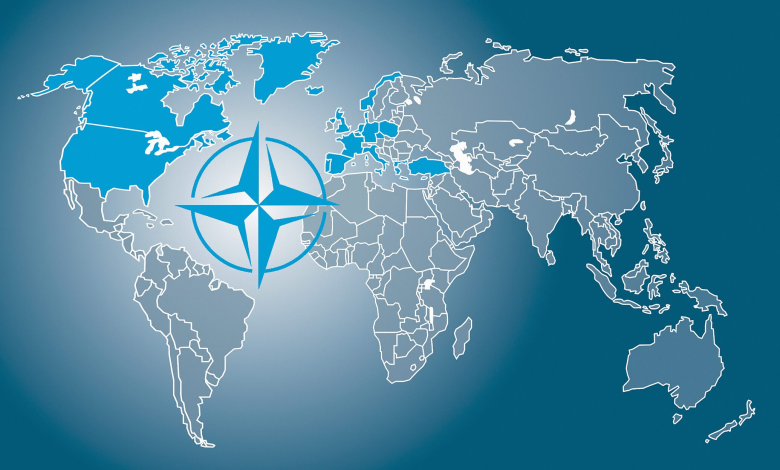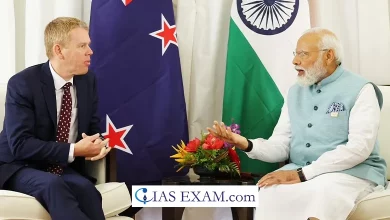Daily Current Affairs for UPSC
North Atlantic Treaty Organization (NATO)
Syllabus- International Organisation [GS Paper-2]

Context- The North Atlantic Treaty Organization (NATO), according to a senior American official, is “open” to expanding relations with India.
About NATO
- The United States, Canada, and a number of Western European nations signed the North Atlantic Treaty (also known as the Washington Treaty) in April 1949 to form a military alliance to provide collective defense against the Soviet Union.
- At the moment, there are thirty member states.
- Belgium, Canada, Denmark, France, Iceland, Italy, Luxembourg, the Netherlands, Norway, Portugal, the United Kingdom, and the United States were the initial members of the group.
- Greece and Turkey signed the document in 1952; West Germany signed it in 1955; Spain signed it in 1982; the Czech Republic signed it in 1999; Bulgaria, Estonia, Latvia, Lithuania, Romania, Slovakia, and Slovenia (2004); Albania and Croatia signed it in 2009; Montenegro (2017); and North Macedonia signed it in 2020.
- In 1966, France withdrew from NATO’s integrated military command. However, it remained a member of the organization, and in 2009, it resumed its position in the military command.
- Sweden and Finland have expressed an interest in joining NATO recently.
- Headquarters: Brussels, Belgium.
- Headquarters for Operations of the Allied Command: Mons, Belgium..
Objectives of NATO
- Through political and military means, the primary and enduring goal of NATO is to ensure the freedom and safety of all its members.
- Political objectives: NATO encourages democratic principles and makes it possible for its members to consult with one another and work together on defense and security-related issues to resolve issues, build trust, and ultimately prevent conflict.
- Military Objectives: NATO is committed to peaceful conflict resolution. It has the military capability to conduct crisis-management operations if diplomatic efforts fail.
- These are carried out either independently or in conjunction with other nations and international organizations under a mandate from the United Nations or in accordance with the collective defense clause of the founding treaty of NATO, Article 5 of the Washington Treaty.
- NATO has only used Article 5 once, on September 12, 2001, following the attacks on the World Trade Center in New York City on September 11, 2001.
Functions of NATO
- Although the military command structure of NATO is integrated, very few of its forces or assets are entirely its own.
- Until member nations agree to take on tasks related to NATO, the majority of forces remain under full national command and control.
- The Alliance’s decisions must be unanimous and consensual, and its members must respect the Alliance’s fundamental values of democracy, individual liberty, and the rule of law. All 30 allies have equal say.
- Members’ internal coups and civil wars are not covered by NATO.
- Members of NATO contribute funding. Three-quarters of NATO’s budget comes from the United States.
Origin of NATO
- Western Europe was economically depleted and militarily weak after World War II in 1945 because the western Allies had drastically and quickly reduced their armies.
- The Marshall Plan was implemented in 1948 by the United States and provided massive economic aid to western and southern European nations in exchange for cooperation and joint planning to accelerate their recovery.
- Regarding military recovery, the Western European Union, a collective defense agreement, was concluded as part of the 1948 Brussels Treaty between the United Kingdom, France, and the Low Countries (Belgium, the Netherlands, and Luxembourg).
- However, it was soon realized that a more powerful alliance would be needed to provide the Soviets with a sufficient military counterweight.
- The three governments began discussing a multilateral collective defense plan in March 1948, following a virtual communist coup d’état in Czechoslovakia in February. This plan would improve Western security and promote democratic values.
- These conversations were ultimately joined by France, the Low Nations, and Norway and in April 1949 brought about the North Atlantic Arrangement.
- Regarding military recovery, the Western European Union, a collective defense agreement, was concluded as part of the 1948 Brussels Treaty between the United Kingdom, France, and the Low Countries (Belgium, the Netherlands, and Luxembourg).
- The deteriorating relations between the United States and the Soviet Union after World War II eventually led to the Cold War.
- The US viewed the USSR’s ideology as a threat to its way of life, while the USSR sought to expand its influence in Europe through the spread of communism.
- The Soviet Union joined the socialist countries of Central and Eastern Europe to the Warsaw Pact in 1955, at the height of the Cold War. As a political-military alliance, the Pact was seen as NATO’s direct strategic counterweight.
- Bulgaria, Czechoslovakia, East Germany, Hungary, Poland, and Romania were all included. Albania withdrew in 1968.
- Following the dissolution of the Soviet Union itself, the Pact was officially disbanded in early 1991.
Alliances of NATO
- There are three alliances NATO is a part of that extend its influence beyond its 30 member nations.
- Euro-Atlantic Partnership Council (EAPC): It is a 50-nation multilateral forum for Allies and partner nations to discuss and consult on political and security-related issues.
- It establishes the overall political framework for NATO’s collaboration with partner nations in the Euro-Atlantic region as well as the bilateral relationships established between NATO and individual partner nations as part of the Partnership for Peace (PfP) program.
- A program of practical bilateral cooperation between NATO and individual Euro-Atlantic partner nations is the Partnership for Peace (PfP).
- It lets partners choose their own priorities for cooperation with NATO and build a unique relationship with it.
- Euro-Atlantic Partnership Council (EAPC): It is a 50-nation multilateral forum for Allies and partner nations to discuss and consult on political and security-related issues.
- The North Atlantic Cooperation Council (NACC), which was established in 1991 shortly after the end of the Cold War, was replaced by the EAPC, which was established in 1997.
- Mediterranean Dialogue: It is a partnership forum that aims to improve relations between participating nations and NATO Allies and contribute to security and stability in NATO’s Mediterranean and North African neighbors.
- Currently, the Dialogue is attended by the following non-NATO nations: Tunisia, Egypt, Israel, Jordan, Mauritania, and Algeria are the other countries.
- Istanbul Cooperation Initiative (ICI): By giving non-NATO nations in the Middle East a chance to work with NATO, this partnership forum hopes to contribute to long-term global and regional security.
- The Initiative currently has participation from Bahrain, Kuwait, Qatar, and the United Arab Emirates.





.png)



